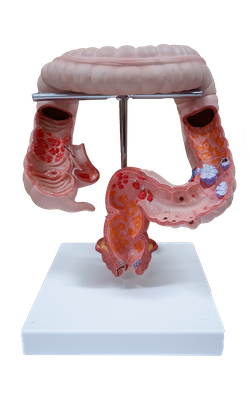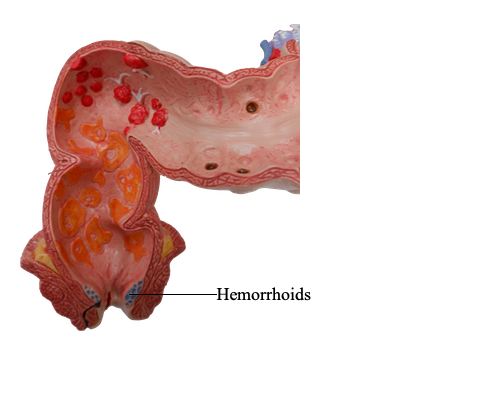Main Model

Hemorrhoids

Vascular Disorder of Bowel
The largest portion of the gastrointestinal tract is supplied
by the celiac, superior mesenteric, and inferior mesenteric
arteries. As they approach the intestinal wall, the superior
and inferior mesenteric arteries fan out to form the mesenteric arcades. Interconnections between arcades, as well as
collateral supplies from the proximal celiac and distal
pudendal and iliac circulations make it possible for the
small intestine and colon to tolerate slowly progressive loss
of the blood supply from one artery. By contrast, acute
compromise of any major vessel can lead to infarction of
several meters of intestine.
Hemorrhoids
Hemorrhoids are dilated anal and perianal collateral
vessels that connect the portal and caval venous systems
to relieve elevated venous pressure within the hemorrhoid
plexus. Thus, although hemorrhoids are less serious than
esophageal varices, the pathogenesis of these lesions is
similar. They are common, affecting about 5% of the general
population. Common predisposing factors include constipation and associated straining, which increase intraabdominal and venous pressures, venous stasis of pregnancy,
and portal hypertension.
Collateral vessels within the inferior hemorrhoidal
plexus are located below the anorectal line and are termed
external hemorrhoids, while those that result from dilation
of the superior hemorrhoidal plexus within the distal rectum
are referred to as internal hemorrhoids. On histologic
examination, hemorrhoids consist of thin-walled, dilated,
submucosal vessels beneath anal or rectal mucosa. These
vessels are subject to trauma, which leads to rectal bleeding.
In addition, they can become thrombosed and inflamed.
Hemorrhoids often manifest with pain and rectal bleeding, particularly bright red blood seen on toilet tissue.
Hemorrhoids also may develop as a result of portal hypertension, where the implications are more ominous. Hemorrhoidal bleeding generally is not a medical emergency; treatment options include sclerotherapy, rubber band ligation, and infrared coagulation. In severe cases, hemorrhoids may be removed surgically by hemorrhoidectomy.
Summary
Vascular Disorder of Bowel
• Hemorrhoids are collateral vessels that form in response to
venous hypertension.